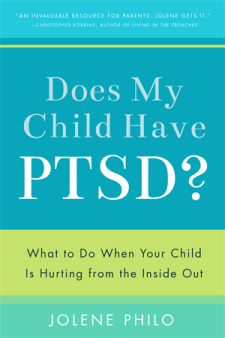Kids, trauma, and PTSD: Book Review

Does My Child Have PTSD? What do To When Your Child Is Hurting from the Inside Out by Jolene Philo

Book review by Kathy Kuhl
Kids with PTSD? Isn’t that just for soldiers and civilians caught in combat? Jolene Philo explains why not—and much more—in this excellent book.
[Kathy’s series on teaching struggling writers resumes next week.]
Jolene Philo begins by telling her family’s PTSD story, and she tells it well. Born in 1982 with a disconnected esophagus and other medical challenges, their son, Allen, endured many surgeries in his first years of life. But then, it was thought dangerous to sedate small babies. And then, experts thought small children could not remember.
Yet by six months of age, Allen “screamed bloody murder when anyone in a white coat entered the room,” and drove his tiny fingernails into his mother’s shoulder at the sight of a stethoscope.
Combat is not the only cause of Post Traumatic Stress Disorder (PTSD). Our children and teens can be traumatized by many things, even by watching violence. In this clear, helpful, and much-needed book, Jolene Philo explains trauma and PTSD in children (or Childhood Developmental Trauma), how it is diagnosed and treated, and the importance of prevention and advocacy.
Mrs. Philo divides the remaining eleven chapters into five parts:
- “Facts About Trauma in Children” covers symptoms of trauma in children, and myths and misconceptions about trauma in kids. Those myths include “It’s not PTSD, it’s bad parenting,” “It’s not PTSD, it’s willful disobedience,” “Unborn children can’t experience trauma,” and “Traumatized children are damaged goods and can’t be repaired.”
- The section “A History of Diagnosis and Treatment of PTSD and Childhood Trauma” is clear and informative, helpful for anyone who cares about a traumatized child.
- In “The Anatomy of Childhood Trauma,” she explains our instinctual trauma responses, the causes of childhood trauma, most importantly, the symptoms of unresolved trauma in children and youth of different ages. She explains the difference between experiencing trauma and developing PTSD.
- “Diagnosis and Treatment of Traumatized Children” explains how PTSD in kids is diagnosed, and why and how it is often misdiagnosed. She elaborates on why it is best to “Catch It Early, Treat Them Young,” while still offering hope for parents like her, who only found effective help for her son when he was an adult.
- The last section, “The Importance of Trauma Prevention and Advocacy” provides strategies for preventing childhood developmental trauma (or PTSD). Here Mrs. Philo explains why prevention is helpful even when it is not 100% effective and the importance of nurturing consistent adults in building resiliency in children. She also explains how to give mental “first aid” after a traumatic event, and how to prevent trauma at the doctor’s and dentist’s offices. Finally she explains how parents need to take care to stay mentally healthy themselves (because your child’s trauma can be traumatic for you) and how to become an effective trauma advocate.
What I liked about this book
Jolene Philo is informative, caring, practical, and wise. At the end of each chapter, she provides a few questions for thought or discussion and great resource lists. I think every parent should be familiar with this book.
If you purchase it on Amazon using this affiliate link, you’ll also support this website. Thank you.
What resources have helped you help a child deal with trauma or PTSD? Please answer in the comments section below.



Thank you so much for this thorough review and for adding it to the DifferentDream.com link share!
Thank you for writing this valuable book.